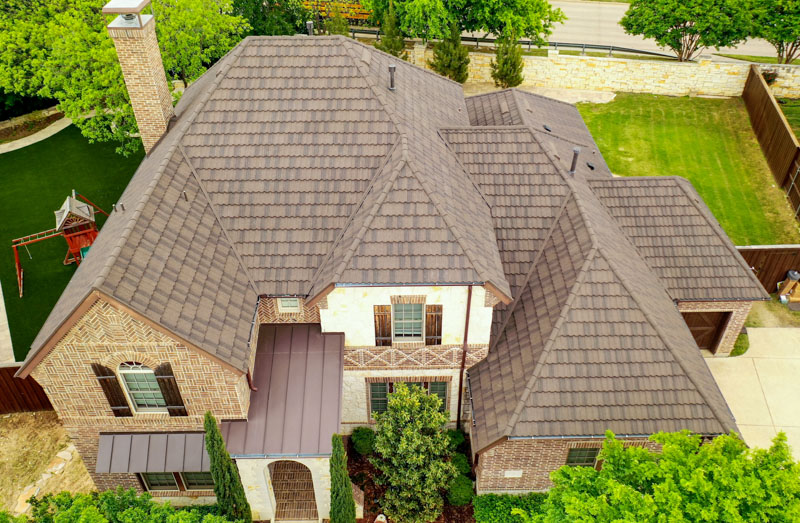Once you have made the decision to install a metal roof on your house and have chosen the color, design and all the other important details, you have to make one last decision. Should you install the metal roof on top of the existing asphalt shingles, or should you remove the shingles first and then put the roof on?
As with any investment in your home, the answer depends on a large variety of factors, which we will detail below. There are many considerations, so you should not rush into making this decision.
In This Article
Why Opt for Metal Roofing?
As soon metal roofing companies made metal materials more visually attractive, the metal roof craze started to take the residential housing market by storm. The way this trend is growing, it could very well become the number one choice for residential roofing.
Metal roofing only ever had one disadvantage, and that was that it looked inappropriate for family homes. When people think of metal roofing, they recall utilitarian warehouses with simple, functional roofs. However, this design is far in the past with recent innovations in metal roof technology.

With the aesthetic problem well and truly solved, metal roofing has a multitude of advantages over traditional roofing materials, like asphalt shingles, wooden shake and clay tiles.
• Cost. Even though metal roofing can be more expensive than a traditional asphalt roof, that extra expense more than pays for itself in time. Most metal roofs have lifetime warranties and the roofs last for the life of the house. They can also reduce climate control expenses by reflecting sunlight in hot months or absorbing heat in cold ones.
• Recycling. It is no surprise to many that metal roofs are the eco-friendly option. Metal roofs are recyclable, and many companies use steel roofs which are completely recycled. Asphalt, wood and clay do not recycle, increasing the waste footprint of homeowners with traditional shingles.
• Fire protection. Metal roofs are not fire hazards. They won’t catch fire from a lightning strike – in fact they disperse the electric charge, rendering it less harmful – and they won’t collapse as easily when an outside disaster compromises the home’s structural integrity.
• Durability. When a professional installer puts the roof on in the proper way, metal roofs are resistant to winds as high as 120 mph, speeds that would tear apart most asphalt roofs. A hard material like steel will also resist hailstorms that would leave asphalt shingle roofs in need of repair.
• Lifespan. Metal roofs can last up to or beyond 50 years, whereas you will need to replace your asphalt shingles every 17 years, on average. That is an advantage when it comes time to put your house on the market.
• Energy-efficiency. Traditional shingles do not have energy-efficient capabilities. Metal roofs reflect heat from your roof’s surface. Metal roofs help keep heat in your home during the winter and allow for efficient ventilation during the summer. As a result, you can see a significant reduction in your heating and cooling costs.
The Important Installation Decision
With the metal shingles set to go on your roof, you must now decide whether to remove your asphalt shingles first or just lay the metal roofing over top. There are valid reasons to either decision, which we will discuss below.

Reasons to overlay (keep existing shingles):
- It’s cheaper. With no time spent on tearing off old shingles, laying down the metal roof over shingles is a cheaper installation. This gives you more money to either upgrade your metal roof or make other home improvements.
- The environment. You cannot recycle old shingles. Outside of the installation process, shingles break off easily and you will accumulate a lot of waste. You will have to send your shingles to a landfill. Putting your roof on top of the shingles saves landfill space and helps the environment.
- Better insulation. The old asphalt shingles will act as insulation in addition to any proper insulation you install. This can reduce your heating costs during the winter.
- It’s faster. Putting your metal roof on top of your old shingles allows you to do the job faster. Why waste time when you can do a better job even sooner?
Reasons to remove existing shingles:
- Building codes. If you already have two layers of roofing, most building codes will not permit you to put down another layer.
- Status of the shingles. If the shingles have too much rot or are too warped, you may not be able to lay the metal roof on top of them. Check with a professional if you are unsure.
- Appearance. If there are any waves, bumps, or other imperfections in your existing roof, your roof installer won’t have a perfectly flat surface to install your new roof over. Removing existing shingles guarantees a perfect surface to install the new roof.
- Moisture from improper installation. If the roofers do not install the metal roof properly, moisture can form in the gap between the two roofs and start to degrade the whole structure. This is mostly a problem with do-it-yourself projects.
Each roofing project is a different scenario, and the right decision is completely dependent on your personal circumstances. Your roofing contractor will be able to assess all of the above criteria for you and recommend the best approach for your home. Opt for a metal roof today for top value and high-quality design.
